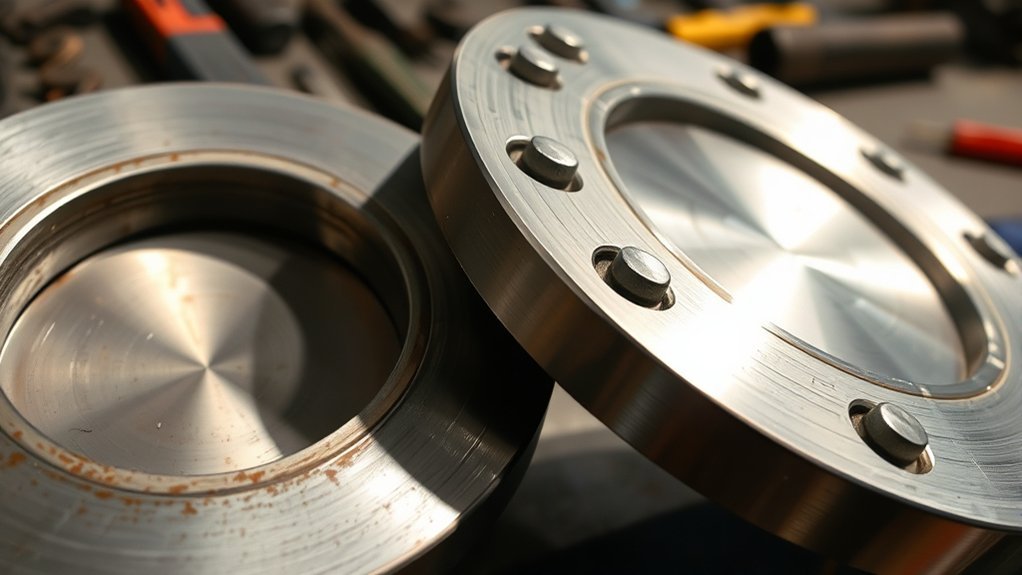Flange sizes can be a tangled web of confusion, where myths often masquerade as facts. You might think that flanges of the same nominal size are interchangeable, but that assumption can lead to costly mistakes. Understanding the nuances of flange dimensions, pressure ratings, and material standards is essential. As you navigate these complexities, consider how your choices impact performance and safety—what you discover may change your approach to engineering decisions.
Common Misconceptions About Flange Sizes
What do you really know about flange sizes? Many misconceptions cloud this topic, leading to confusion in applications.
One common myth is that all flanges of the same nominal size are interchangeable. In reality, variations exist in dimensions, pressure ratings, and materials across different standards like ANSI, ASME, and DIN.
Another misconception is that larger flanges always equate to higher pressure capabilities, which isn’t true; pressure ratings depend on the material and design.
People often assume that flange size only affects assembly, ignoring its impact on flow rates and system efficiency. Understanding these nuances is vital for anyone involved in piping design or maintenance, as it directly affects system integrity and performance.
Clarifying these myths can lead to better decision-making in engineering contexts.
The Importance of Selecting the Right Flange Size
Selecting the right flange size is essential for ensuring ideal performance in piping systems, as improper sizing can lead to leaks, increased maintenance costs, and compromised safety. When you choose the correct flange, you optimize system integrity and performance.
| Flange Size | Potential Issues | Recommended Practices |
|---|---|---|
| Small | Increased pressure | Evaluate pressure ratings |
| Large | Misalignment | Check compatibility |
| Incorrect | Leaks | Follow manufacturer specs |
| Oversized | Unnecessary costs | Assess flow requirements |
| Undersized | System failure risk | Perform accurate calculations |
How Flange Size Affects Performance and Safety
Flange size directly impacts both performance and safety in piping systems. When you select a flange that matches the pipe diameter and pressure rating, you enhance flow efficiency and minimize turbulence. An undersized flange can lead to increased pressure drops, causing operational inefficiencies and potential failure.
On the safety front, improper sizing may result in leaks or catastrophic failures due to stress concentrations. Additionally, oversized flanges can complicate installation and maintenance, creating additional risks. Ensuring the correct flange size not only optimizes system performance but also safeguards against hazardous incidents.
To maintain system integrity, always consider the material compatibility and environmental factors that could influence the flange’s effectiveness under operational conditions.
Modern Standards vs. Outdated Practices
While many industries still rely on outdated practices for flange sizing, modern standards provide critical guidelines that enhance safety and efficiency in piping systems.
Sticking to old methods can lead to various issues, including leaks and equipment failures. By adopting contemporary standards, you can guarantee better compatibility and performance.
Consider these key aspects of modern standards:
- Accurate pressure ratings to prevent failures
- Improved material specifications for durability
- Enhanced dimensional tolerances for better fit
- Rigorous testing requirements for safety
- Updated installation guidelines to reduce errors
Tips for Choosing the Appropriate Flange Size
When considering the appropriate flange size for your application, it’s important to assess several factors that impact system performance and safety.
Start by evaluating the operating pressure and temperature; these parameters directly influence the flange’s material and thickness.
Next, consider the pipe diameter and the type of connection—welded or threaded—as this affects compatibility.
Don’t overlook the fluid type; corrosive substances may necessitate specific materials.
Additionally, check industry standards and codes relevant to your application; compliance promotes reliability.
Finally, think about future maintenance and accessibility; choosing a size that allows for easy disassembly can save time and resources.
Frequently Asked Questions
Can Flange Size Impact the Cost of Materials?
Yes, flange size can impact material costs. Larger flanges often require more raw materials and specialized manufacturing processes, leading to increased expenses. Conversely, smaller sizes might reduce costs but could affect performance in specific applications.
Are There Universal Flange Sizes for All Applications?
There’s no one-size-fits-all when it comes to flange sizes. Different applications require specific dimensions and standards, so you’ll find variations based on industry requirements, material types, and connection methods. Always consult relevant specifications for your needs.
How Often Should Flange Sizes Be Re-Evaluated?
You should re-evaluate flange sizes regularly, ideally during maintenance cycles or when system changes occur. This guarantees peak performance and compatibility, addressing any potential issues before they escalate into costly failures or operational inefficiencies.
Do Different Industries Have Unique Flange Size Standards?
Yes, different industries do have unique flange size standards. For instance, aerospace demands stricter tolerances than construction. Understanding these variations helps you select the right components, ensuring compatibility and safety in your specific application.
Can Flange Size Affect Maintenance Requirements?
Yes, flange size can greatly affect maintenance requirements. Larger flanges may require more robust sealing and support systems, while smaller ones might lead to increased stress and wear, necessitating more frequent inspections and maintenance interventions.
Conclusion
In managing the complexities of flange sizes, it’s essential to balance convenience with precision. While the allure of interchangeable nominal sizes may seem appealing, the reality of dimensional and material variations demands careful consideration. Choosing the right flange isn’t just about matching sizes; it’s about ensuring safety and performance in your systems. Embracing modern standards over outdated practices can lead to enhanced efficiency and reliability, ultimately safeguarding your operations from the myths that could compromise them.
